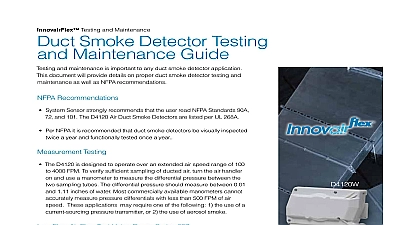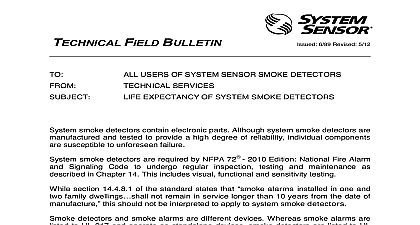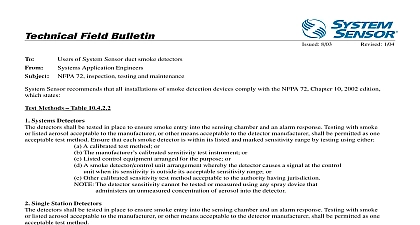System Sensor Smoke Detector Inspection and Testing Guidance

File Preview
Click below to download for free
Click below to download for free
File Data
| Name | system-sensor-smoke-detector-inspection-and-testing-guidance-2906784135.pdf |
|---|---|
| Type | |
| Size | 648.19 KB |
| Downloads |
Text Preview
September 1 2006 Paper Detector Inspection and Testing Guidance Sensor Smoke Detector Inspection and Testing Guidance and inspection requirements for smoke detectors are prescribed by the Fire Protection Association NFPA in the National Fire Alarm Code NFPA The intent of these tests is to ensure proper operation of the detector as installed operated in a re alarm system The purpose of this white paper is to identify required test as de ned in the Code to clarify for architects engineers and re alarm installers in the re protection community as well as authorities having AHJ the different methods to test System Sensor smoke detectors white paper primarily addresses intelligent detectors Additional testing may exist as speci ed by individual manufacturers All NFPA 72 references this document are out of the 2002 edition sensors must be tested after installation and periodically thereafter see NFPA 72 10 Table 10.4.3 Testing Frequencies Sensors offer maximum performance tested and maintained in compliance with NFPA 72 and the manufacturer however it is also necessary to comply with all testing requirements methods of the AHJ sensor that fails the testing methods outlined in this document should be and retested see your detector installation manual for details If the fails after cleaning it must be replaced Testing Detectors proper authorities including any offsite monitoring central station as well as building management security and occupants that the system will be undergoing the audible visible appliances may be activated and the system will be out of service 72 Chapter 10 Inspection and Testing Requirements can be broken down three related but separate tests Visual Inspection Smoke Entry Sensitivity of these is explored in more detail below Inspection Paragraph 10.3 and Table 10.3.1 inspection es physical or conditions not by electrical inspection is required upon initial and any reacceptance testing and thereafter Visual inspection is intended to identify physical or other and conditions that might not be indicated through electrical supervision might include but is not limited to a range of issues dust covers being left in after installation alterations to building structure or changes to the processes the protected area Sensor Advanced Ideas Advanced Solutions Sensor Smoke Detector Inspection and Testing Guidance Entry Testing Paragraph 10.4.2.2 and Table 10.4.2.2 13 g detectors shall be tested in place to ensure smoke entry into the sensing and an alarm response NFPA 72 National Fire Table 10.4.2.2 13 g Detectors smoke entry test requirement is intended to ensure smoke can physically enter sensing chamber of the detector Smoke entry tests may be performed by a of methods but care should be taken to ensure they are non damaging should also be 3rd party e g UL listed One method to perform smoke entry is to use an aerosol generator that produces a measured amount of smoke the test more commonly performed smoke entry test method is that of a pressurized canister While these offer signifi cant attractions for inexpensive simple quick testing they are not without drawback or risk Although not very oily residue from misused or inappropriate product over a period of time make the detector more sensitive and prone to nuisance alarms Chemically formulae could also lead to stress cracking of plastics although again is not very common Furthermore duration of spray angle of aerosol container between detector and aerosol container and environmental conditions can differently with different detectors particularly in today environment of complex and sophisticated sensors In all cases requirements of the of the test medium must be followed For System Sensor Acclimate smoke detectors functional testing must performed before smoke entry testing Magnet tests one form of functional initiate an approximate fi ve minute period when the detector signal software routines are inactive If you do not perform the magnet test the smoke entry test a time delay will activate before the detector alarms to the device internal signal processing algorithms The magnet tests not however replace the need for smoke entry tests See Functional Magnet section for performance details Sensitivity Testing Paragraph 10.4.2.2 and Table 10.4.2.2 13 g calibrated sensitivity test is designed to verify that a detector is operating within listed and approved sensitivity range Paragraph 10.4.3.2.4 of NFPA 72 lists the alternative methods for testing sensitivity of a detector Some intelligent fi re system manufacturers have listed their fi re alarm control panels FACP for purpose Other panels may show the original sensitivity setting of the detector the time of installation Sensitivity measurements may include analog values and percent of alarm though not all sensitivity test devices will measurement Please note that sensitivity testing can also be performed a device that is independent of the alarm system and if the sensitivity test performed by using a device that introduces smoke or surrogate smoke to the the requirements for functional testing would be met note that unlike tests sensitivity tests may not be required or performed every year entry testing smoke can enter the sensing sensitivity veri es the is operating its listed and sensitivity Sensor Advanced Ideas Advanced Solutions Sensor Smoke Detector Inspection and Testing Guidance Frequency 10.4.3 and Table 10.4.3 outline the frequency at which testing is required Paragraph 10.4.3.2 and its subparagraphs address the sensitivity frequency test requirements This for extension of the periods between sensitivity tests under certain circumstances Entry Table 10.4.3 section 15 h requires functional testing smoke entry upon initial and any reacceptance testing as well as annually thereafter OPERATIONAL AND TESTING INFORMATION SPECIFIC TO SYSTEM SENSOR DETECTORS Test System Sensor detectors offer an additional test feature known as magnet tests This test uses a magnet activate the detector thereby testing the detector alarm circuit connections to the control panel and the and effect program such as verifying door closure notification activation and damper operation perform this test hold the test magnet in the magnet test area The sensor will generate an alarm at the Its LEDs which are controlled by the panel will indicate the status of the sensor signals transmitted from the panel can cause the LEDs to blink latch on or latch off Refer to your panel installation guide for sensor LED status operation test does not replace the NFPA 72 requirement for smoke entry tests more information regarding Smoke Detector Testing please contact Sensor Ohio Avenue Charles Illinois 60174 1 800 sensor2 9 06 1704 Sensor Advanced Ideas Advanced Solutions


